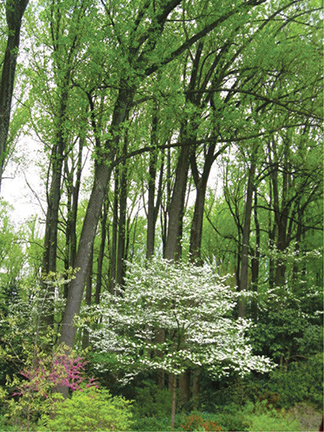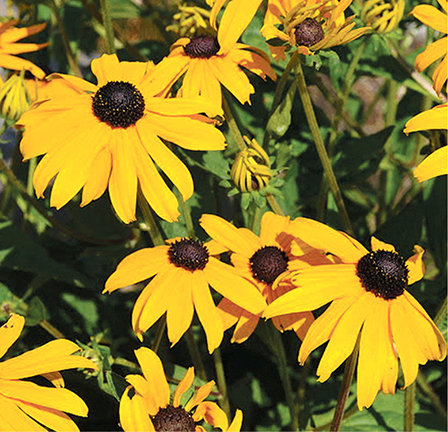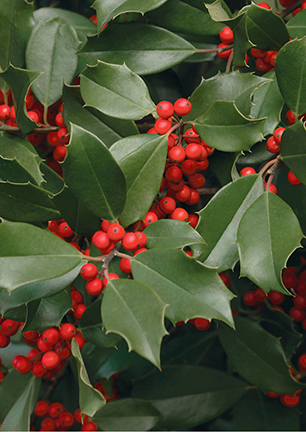Natives Are the Rock Stars of the Plant Kingdom!
 Happy Pride! I love talking about native plants—and since every color of the rainbow can be found with them, they’re a terrific way to display your Pride from spring through autumn and even in winter. And since native plants are acclimated to our region, using them in your garden almost guarantees a successful landscape. Let’s chat about a few.
Happy Pride! I love talking about native plants—and since every color of the rainbow can be found with them, they’re a terrific way to display your Pride from spring through autumn and even in winter. And since native plants are acclimated to our region, using them in your garden almost guarantees a successful landscape. Let’s chat about a few.
Trees: The workhorses of the plant community, they provide shelter, food, beauty, and a little thing called oxygen. They also have provided our nation and the world over with an invaluable resource of building material and fuel. Indeed, where would we be without them?
Acer rubrum, the Red Maple, can be found throughout our region and is well suited to our soils and performs extremely well in wet environments. It provides an astounding display of color during the fall months. In the spring, groupings of red maples are easy to spot—their swollen buds appear as a reddish mist above the branches, just before the leaves unfurl.
Ilex Opaca, the American Holly, is Delaware’s State Tree and a valuable forest native. Occurring throughout Delaware as an understory tree in our forests, these trees provide shelter, food, and abundant beauty in our winter landscapes. A slow grower, the straight species of American holly is rarely sold in nurseries. Instead, there are numerous cultivars.
What is this word, cultivar? Many of the plants at nurseries are either cultivars or varieties, and the difference is big. A variety is naturally occurring in nature, like the white flowering Redbud. But a cultivar is grown by selective breeding. This means that if you plant a seed from a cultivar, you might get a very different looking plant.
 Cultivars are found throughout the region and are more often better suited to our gardens. American hollies require both a male and female plant in order to produce berries, so make sure you have a male holly somewhat nearby.
Cultivars are found throughout the region and are more often better suited to our gardens. American hollies require both a male and female plant in order to produce berries, so make sure you have a male holly somewhat nearby.
Quercus phellos, the Willow Oak, is a superb shade tree with a finer texture than other oaks, plus it turns wonderful shades of orange in autumn. The leaves resemble those of the willow tree and the acorns are somewhat smaller than most oaks. It grows at a medium rate and likes moist but well-drained soils. However, willow oaks can adapt to almost any soil type, which is why they make a great choice for street trees.
Ornamental Trees: These are the trees we love to see and smell when their flowers emerge and display their brilliance. Native ornamental trees are under appreciated and have been overshadowed by their non-native counterparts in our area. However, our natives can be just as beautiful and enduring, and are quite important to our local wildlife.
Amelanchier arborea, Downy Serviceberry, is a perfect addition to a garden, especially for those who enjoy bird watching—the purplish fruit is devoured by birds. However, the berries are also quite tasty to humans and from what I have read, make a delicious pie. They can be found in a wide range of soil types and are considered salt spray tolerant, so they can be a great addition to the coastal garden.
 Cercis Canadensis, Eastern Redbud, is a stunner in the native landscape. Its fuchsia petals seem to climb on every branch in early spring before the trees leaf-out. Cultivars available today include those with purple, chartreuse, and deep green leaves; one called Rising Sun has new leaves a wondrous golden yellow that turn to bright green.
Cercis Canadensis, Eastern Redbud, is a stunner in the native landscape. Its fuchsia petals seem to climb on every branch in early spring before the trees leaf-out. Cultivars available today include those with purple, chartreuse, and deep green leaves; one called Rising Sun has new leaves a wondrous golden yellow that turn to bright green.
Shrubs: Shrubs are the backbone of our home landscapes. They provide structure, form, color, texture, habitat, aroma—virtually every sense can be excited by them. Here are a couple of my favorites:
Clethra alnifolia, Summersweet, is a gorgeous addition to the garden. It provides sweet smelling flowers in the summer and tolerates shade and wet areas. It even can tolerate some flooding by slightly brackish water. Summersweet is a tremendous resource to wildlife and is virtually pest and disease free.
Ilex verticillata, Winterberry, is one of my favorite all-time shrubs. It can grow rather large, but smaller cultivars exist for tighter spaces. The berries produced on winterberry are an explosion of color in the autumn and winter months and can last sometimes until January. Native to swampy areas, it does extremely well in wet conditions and can even tolerate wet feet. A must-have in the native garden.
Perennials: Just like the shrubs, the list of native perennials is far-reaching. They are a glorious part of the garden, providing color and fragrance from spring until harvest time. They also provide an important food source for many pollinators.
Baptisia australis, Blue False Indigo, is magical in the native landscape. Its violet-blue pea-like flowers stand above the foliage in late spring. Their seeds, in large pods, can be sown in fall for additional plants. It can be slow at first, but once established you will be amazed at the size and beauty. A must-have for those who love blue flowers.
Rudbeckia fulgida, Black-eyed Susan, continues to provide beautiful displays year after year. Another low-maintenance perennial that should have a place in every sunny border, their yellow bursts of flowers over their deep green leaves make the garden glow with excitement.
This just touches on the many native plants that adorn our little neck of the woods. Just with these plants above, you could have your own Pride garden with all the colors of the rainbow. For more information check out the library, local nurseries, the internet, even your local landscape architect (wink, wink). So go out and enjoy all that our native plants have to offer, and let’s garden together! ▼
Eric W. Wahl, RLA is a landscape architect at Element Design Group and president of the Delaware Native Plant Society.
